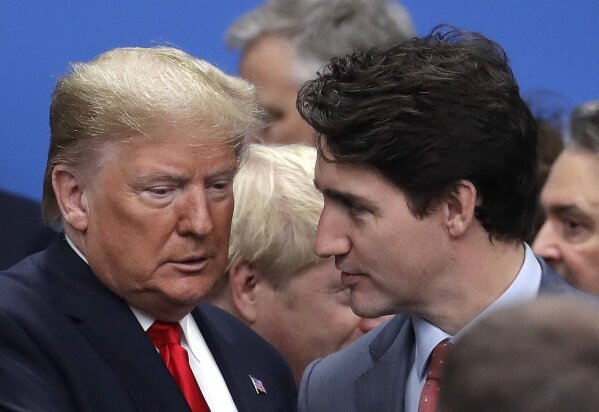
The Evolving Drama of American Foreign Policy Under Trump
Trump’s second-term foreign policy has shifted into a spectacle of unpredictable economic strategies and diplomatic tension. From misguided tariff policies that raise consumer prices to reciprocal trade wars straining historic alliances like those with Canada and the EU, Trump’s actions are reshaping America’s global standing. The result: inflation, fractured diplomacy, and a stage where power politics eclipses long-term strategy.
Donald Trump’s approach to foreign policy in 2023, highlighting the absurdity of his economic strategies and their implications for international relations.
As someone who’s been following politics for decades, it’s hard to fathom that in his second term, Donald Trump has managed to create a political spectacle that raises eyebrows and stirs debates. This past week was no exception, as his actions turned the realm of foreign policy into a circus show—filled with questionable strategies and bizarre assertions that challenge conventional wisdom. Together, let’s unravel the intricacies of this chaotic political landscape.
The Illusion of Economic Warfare: Tariffs and Their True Cost
In recent years, tariffs have become a hot topic in American economic policy. Under President Donald Trump, the reintroduction of tariffs was framed as a strategy to protect local industries. But what are the real implications of these tariffs? Are they truly beneficial, or do they come with hidden costs? Let’s break down Trump’s tariff proposals and their intended goals.
Understanding Trump’s Tariff Proposals
Trump’s administration has made headlines with its aggressive tariff policies. The idea was simple: impose tariffs on foreign goods to protect American jobs. But the reality is more complex. Here are some key points to consider:
- Protectionism vs. Free Trade: Trump argued that tariffs would shield American industries from foreign competition. However, this protectionism can lead to higher prices for consumers.
- Reciprocal Tariffs: Trump proposed a system where tariffs would be imposed on countries that impose tariffs on the U.S. This approach misunderstands the dynamics of international trade.
- Misconceptions: Many of Trump’s claims about tariffs are based on misunderstandings of trade balances and economic theory.
As the commentator noted, “The idea that tariffs will magically fix the economy is a fallacy.” This statement encapsulates the flawed logic behind the tariff strategy. Tariffs are not a silver bullet; they can create more problems than they solve.
The Impact of Tariffs on American Consumers
One of the most significant consequences of tariffs is their impact on American consumers. When tariffs are imposed, the costs are often passed down to consumers. For example, consider the case of Apple’s iPhone. If a 20% tariff were applied, the price could jump from €1,000 to €1,200. This increase affects everyday Americans who rely on these products.
Moreover, tariffs can lead to inflation. When prices rise due to tariffs, consumers have less purchasing power. This can create a ripple effect throughout the economy, leading to decreased spending and slower economic growth.
Global Trade Dynamics
Tariffs also have broader implications for global trade. They can strain relationships with traditional allies and disrupt established supply chains. For instance, Trump’s tariffs on European goods have led to tensions with the EU and Canada. These countries may retaliate with their own tariffs, creating a cycle of economic warfare.
Additionally, the automotive industry has felt the impact of these policies. Many American companies have outsourced production to countries with cheaper labor. Tariffs can complicate these arrangements, leading to higher costs and potential job losses in the U.S.
Debunking Misconceptions About Trade Imbalances
There is a common misconception that tariffs can correct trade imbalances. However, this view oversimplifies a complex issue. Trade imbalances are influenced by various factors, including currency values, consumer preferences, and economic policies.
- Currency Valuation: A strong dollar can make American goods more expensive abroad, contributing to trade deficits.
- Consumer Preferences: American consumers often prefer foreign products due to quality and price. Tariffs do not change these preferences.
- Economic Policies: Structural issues within the U.S. economy, such as wage stagnation and productivity, play a significant role in trade imbalances.
Trump’s narrative that tariffs will solve these issues is misleading. Instead of addressing the root causes, tariffs merely shift the burden onto consumers and businesses.
Trump’s tariff proposals were intended to protect American industries but have significant drawbacks. They can lead to higher prices for consumers, strain international relationships, and fail to address the underlying issues of trade imbalances. As the economic landscape continues to evolve, it is crucial to critically assess the effectiveness of such policies and their long-term implications for the American economy.
Unpacking the ‘Arancel Recíproco’: More Harm Than Good?
The concept of reciprocal tariffs has become a hot topic in international trade discussions. But what does it really mean? In simple terms, reciprocal tariffs are a tit-for-tat approach to trade. If one country imposes tariffs on another, the affected country retaliates with its own tariffs. This cycle can lead to escalating tensions and, ultimately, trade wars. Is this really the best way to handle international trade?
Dissecting the Notion of Reciprocity in Trade Tariffs
Reciprocity in trade tariffs sounds fair on the surface. However, it often complicates international relations. When countries engage in this back-and-forth, they risk damaging long-standing alliances. For instance, President Trump’s administration has frequently used this strategy, claiming it protects American jobs and industries. But does it?
- Escalation of Tensions: As noted, “Reciprocal tariffs only escalate tensions and complicate international relations.” This statement rings true as countries retaliate against each other, leading to a cycle of conflict.
- Economic Misunderstandings: Many argue that Trump’s understanding of tariffs is flawed. He often suggests that tariffs will magically balance trade deficits, ignoring the complexities of global economics.
Examples of Countries Affected by Trump’s Tariff Regime
Several countries have felt the impact of Trump’s tariff policies. Notably, Canada and the European Union have been major targets. These nations have faced significant tariffs on various goods, from steel to automobiles. The consequences have been profound.
- Canada: As a close ally, Canada was shocked by the sudden imposition of tariffs. The Canadian government responded with its own tariffs, leading to strained relations.
- European Union: The EU has also been affected. Trump’s tariffs on European goods have led to retaliatory measures, further complicating trade negotiations.
These examples illustrate how reciprocal tariffs can create a domino effect. One country imposes tariffs, and the other responds in kind. The result? Increased costs for consumers and businesses alike.
Discussing the Long-Term Economic Implications of Such Policies
The long-term economic implications of reciprocal tariffs are concerning. Economists warn that these policies can lead to inflation. When tariffs are imposed, the cost of imported goods rises. This means consumers pay more for everyday items. For example, if a 20% tariff is placed on an iPhone, its price could jump from €1,000 to €1,200. Who bears the burden? The consumer.
Moreover, the impact on American manufacturing is significant. Many companies have moved production overseas to cut costs. Trump’s tariffs do little to address the root causes of this trend. Instead, they may exacerbate it by making imported materials more expensive.
- Inflation: Increased costs for imported goods can lead to higher prices across the board.
- Manufacturing Challenges: Companies may struggle to adapt to new tariffs, leading to job losses and economic instability.
In the end, the notion of reciprocity in tariffs may seem appealing, but the reality is far more complex. Countries like Canada and the EU have already felt the sting of Trump’s policies. The long-term economic implications could be dire, affecting consumers and businesses alike.
As the world watches, the question remains: Is this the right approach to trade? Or are we witnessing the beginning of a more complicated and contentious era in international relations?
Allies Under Threat: The Fallout of Unprecedented Measures
In recent months, the political landscape has shifted dramatically under the leadership of U.S. President Donald Trump. His policies have raised eyebrows, particularly regarding their implications for international alliances. One of the most affected countries is Canada, a long-standing ally of the United States. The fallout from Trump’s economic strategies has left many questioning the future of these relationships.
The Implications of Trump’s Policies on US Alliances
Trump’s approach to international relations has been anything but conventional. His economic policies, especially regarding tariffs, have sparked outrage among allies. For instance, Canada has expressed significant concern over the potential strain on their relationship with the U.S. due to these tactics. The imposition of tariffs on Canadian goods could lead to a trade war, which would be detrimental to both economies.
Historically, alliances like that between the U.S. and Canada have been built on mutual trust and cooperation. However, Trump’s recent actions have put this foundation at risk. The question arises: can historical alliances withstand such turbulence? The answer is complex. While many believe that strong ties can endure, the current climate suggests that trust is eroding.
The Response from Global Economic Leaders
Global economic leaders have reacted swiftly to Trump’s strategies. Many have criticized his approach, arguing that it undermines decades of diplomatic efforts. Economists warn that the proposed tariffs could lead to increased costs for consumers. For example, a 20% tariff on products like Apple’s iPhone could raise prices significantly, from €1,000 to €1,200. This would not only affect American consumers but also disrupt international markets.
Moreover, the narrative that other nations are “stealing” from the U.S. has been met with skepticism. Many leaders argue that such claims are oversimplified and ignore the complexities of global trade. As one commentator noted, “Diplomacy is at risk when economic decisions jeopardize historical relationships.” This sentiment resonates with many who fear that Trump’s policies could lead to a breakdown in communication and collaboration among nations.
Can Historical Alliances Withstand Such Turbulence?
The resilience of historical alliances is being tested like never before. The U.S. has long relied on its partnerships to navigate global challenges. However, Trump’s aggressive stance raises questions about the future of these relationships. Will allies like Canada continue to support the U.S. if they feel threatened by its policies? Or will they seek new partnerships that align more closely with their interests?
As tensions rise, the potential for a shift in alliances becomes more pronounced. Countries may begin to reassess their relationships with the U.S., especially if they perceive a lack of stability in American leadership. The implications of this shift could be far-reaching, affecting everything from trade agreements to military cooperation.
The Broader Geopolitical Landscape
The current situation reflects a broader struggle between the U.S. and rapidly modernizing nations like China. Trump’s policies seem to be pushing allies away, while simultaneously fostering closer ties between other countries. This shift could lead to a realignment of global power dynamics, with significant consequences for international relations.
In conclusion, the fallout from Trump’s unprecedented measures is profound. The implications for U.S. alliances, particularly with Canada, are serious. Global economic leaders are voicing their concerns, and the future of historical alliances hangs in the balance. As the world watches, the question remains: will diplomacy prevail, or will economic decisions jeopardize relationships built over decades? The answer will shape the future of international collaboration and stability.
TL;DR: Trump’s recent foreign policy moves have created confusion and controversy, leading to significant implications for both domestic and international arenas, making his leadership a stage for political theater.
PoliticalSatire, ChinaTradeRelations, TrumpEconomicStrategy, TariffsAndTradeConflicts, USInternationalRelations, UkraineWarSupport, AmericanPolitics2023, TrumpForeignPolicy, EconomyTrumpPresidency, PoliticalAnalysis
#TrumpEconomicStrategy, #PoliticalAnalysis, #ChinaTradeRelations, #PoliticalSatire, #USInternationalRelations, #TrumpForeignPolicy, #EconomyTrumpPresidency, #AmericanPolitics2023, #TariffsAndTradeConflicts, #UkraineWarSupportTrumpForeignPolicy, #TradeWar, #TariffImpact, #USCanadaRelations, #GlobalAlliances, #PoliticalTheater, #EconomicFallout, #ReciprocalTariffs, #GlobalTrade, #InternationalTensions

